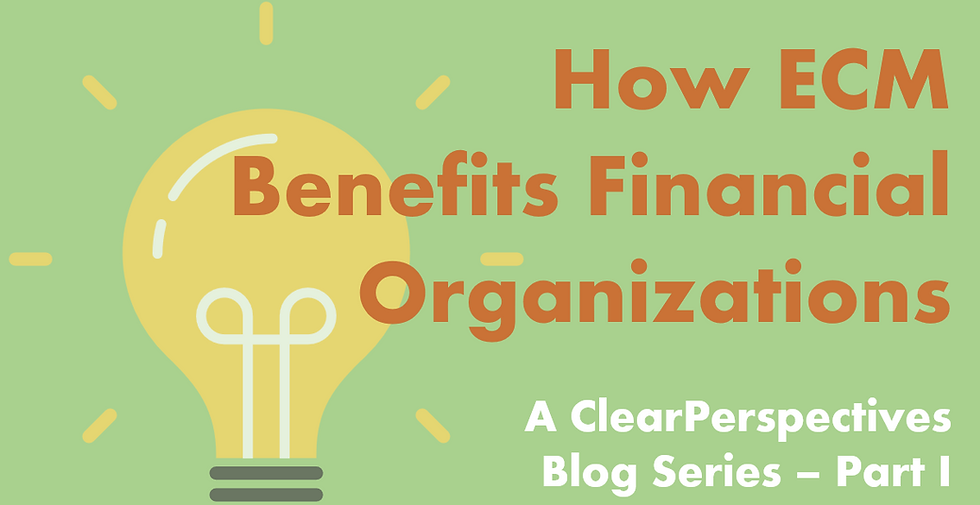Let Your Content Work For You! Part One
- David Dye
- Feb 21, 2023
- 4 min read
Updated: Oct 1, 2024

The first in a three part series
By David Dye, Co-Founder
Way back in January of 1996, Bill Gates penned an essay entitled “Content Is King.” He wrote about how money would be made on the internet through content, using broadcasting as an example, but he was also prescient enough to see how content could help individual businesses.
Today, content is the driver for all your business communications, but for many organizations, it can be a struggle to implement proper management and accessibility of content, driving home the need for an Enterprise Content Management (ECM) platform.
An Introduction to ECMs
An ECM is often referred to as a document or records management system. It’s a software application that allows for creation, storage, editing, and publishing of content throughout your organization and out into the marketplace. Unlike a CMS, which is focused on documents only, an ECM is for all forms of content including unstructured data like email, text, video, graphics, photos, audio, and social media.
An ECM is also compatible with open-source, proprietary, and licensed platforms like Alfresco, along with multiple operating systems like Microsoft Windows, Linux, and Android. Third-party users can edit source code through the ECM to suit their organization's needs. Mancy EMCs are also cloud scalable, so you can increate storage and memory capacities, expand networking possibilities, and share processing workloads between a myriad of computing resources.
Almost every type of file can be uploaded into the ECM, such as paper documents, electronic files, emails, images, audio, and video. They are marked and tagged for easy retrieval and can be edited for instant content updates for employees with access privileges from work, home, or afar. Content can be shared across the company, sent out to current and potential clients, and used to fill a variety of marketing and customer service needs.
Specific ECM Benefits for Financial Services Industries
Within the banking industry, an ECM provides an efficient and secure way to process payables and receivables. For traditional banks, digitizing the incoming documents can decrease the time it takes to make credit decisions, leading to faster lending decisions and a significant reduction in costs.
For investment management, an ECM is used to improve investment transparency, helping to ensure the proper disclosure of financial information. With easy access to cataloged documents, financial firms can speed up the process of preparing and distributing financial reports while ensuring the accuracy of information. The ECM also aids in the auditing of workflows, risk management, and in helping the investment firm stay within regulatory compliances.
Regarding insurance agencies, the search function allows users to find the information they need in real time, benefiting the customer experience and helping to assure insurance accountability. Controls can be put on sensitive data to increase security and remain in compliance with industry regulations. Within the treasure trove of information in the ECM, the marketing arm of the organization also has access to the statistics and facts that can boost their standing in the marketplace and improve their marketing efforts with targeted outreach and advertisements.
ECM Benefits for Your Organization and Workforce
With an ECM, your organization will be able to streamline key areas of your business, providing a faster roll-out for new processes as it provides the foundation for customized workflows. With storing and indexing, documents can be found in seconds through simple search and retrieval. If a document needs updating, an approved user with access control can revise a document as needed, with previous copies still saved.
As mentioned previously, an ECM is a secure solution, having the measures in place to eliminate risks, whether they are related to corporate policy, compliances, regulations, or best business practices. By pulling up the exact documents you need, reporting becomes a much easier and streamlined process, lowering costs to your organization, saving valuable employee time, and eliminating the inefficiencies that drag on ROI.
ECM Benefits to Clients
The biggest benefit of an ECM to your clients is the improvement in customer service. With employees having updated documents in one central repository, access is much quicker than searching through multiple electronic files or physical folder cabinets. This leads to more facetime with clients and the opportunity to build stronger bonds.
With a strong partnership with Alfresco, a Hyland Company, ClearCadence supports all your Alfresco project initiatives, including strategizing and implementing an ECM that’s customized to your business. We’ve created ClearView, a powerful standard and single interface for Alfresco Process Services that’s configurable for creating custom search forms, including from mobile devices.
Additionally, our team carries expert-level specializations in workflow, integration, design, analysis, and content-centric activities. We’ll automate data capture, digitize your data, and integrate your ECM throughout your organization, providing end-to-end visibility of content throughout your organization.
By partnering with ClearCadence, we’ll create the right ECM for you and guide you through the process of digital transformation through content management.

David Dye, co-founder and partner of ClearCadence, has over 20 years of successfully developing, selling, growing, maturing and managing profitable professional services practices for Digital Business Process Automation, Content, and Integration software companies.
ClearCadence has a long track record of assisting customers with analyzing, planning, designing, and implementing solutions. Visit the link above to received more information about our organization.


































Comments